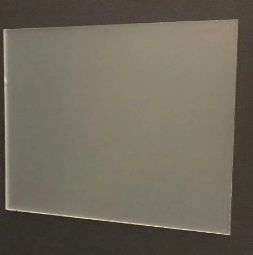
Prismatic vs. Opal: How to Choose the Right Ceiling Light Diffuser Panel for Your Space
Prismatic vs. Opal: How to Choose the Right Ceiling Light Diffuser Panel for Your Space Replacing an old fluorescent light diffuser is one of the
Home » Top 5 Signs It’s Time to Replace Your LED Fixture
LED fixtures are known for their long lifespan, energy efficiency, and low maintenance. But even the best lighting technology doesn’t last forever. Whether you’re lighting an office, warehouse, retail space, or even your home, there comes a time when your LED fixture needs to retire.

The tricky part? LED fixtures don’t always “burn out” in the traditional sense. Instead, they fade, flicker, or fail gradually. So, how do you know when it’s time to stop troubleshooting and start replacing?
Let’s break down the top 5 signs it’s time to replace your LED fixture—and why ignoring them might cost you more than you think.
One of the biggest indicators that your LED fixture is on its way out is reduced brightness or uneven lighting. Unlike traditional bulbs that just go dark, LEDs degrade slowly over time. This phenomenon, called lumen depreciation, means the fixture is still on—but not delivering the brightness it once did.
A once-bright area now looks dull or shadowy.
Some parts of the fixture are dimmer than others.
Colors in the room appear faded or off.
Dimming doesn’t just mess with your lighting aesthetics—it can create safety hazards in commercial or industrial settings, and eye strain in offices or homes.
If cleaning the lens and checking power supply doesn’t help, it’s time to replace the fixture.
Flickering lights aren’t just annoying—they’re a red flag. While occasional flickers can be caused by voltage fluctuations or loose wiring, consistent flickering (especially when paired with buzzing or humming sounds) usually means the fixture’s internal driver is failing.
Most modern LED fixtures have built-in drivers that convert AC power to the low-voltage DC current LEDs need. When these drivers wear out, the LEDs can’t operate properly.
Aside from driving people crazy, flickering can:
Trigger migraines and visual discomfort
Interfere with security camera footage
Shorten the lifespan of surrounding electrical components
If your fixture flickers often and you’ve ruled out external issues, it’s time to replace it.
Ever notice that your LED fixture looks a little more… amber than usual? Over time, the plastic diffusers or lenses in LED fixtures can yellow or discolor due to heat, UV exposure, or age.
Alters color temperature and overall ambiance
Reduces light transmission, making the fixture seem dimmer
Impacts energy efficiency (you need more fixtures to achieve the same brightness)
This is especially common in older fixtures or those installed in areas with high heat or humidity. If your cover is discolored or warped, it may be time to replace either the lens—or the whole fixture if parts aren’t available.
LED technology has come a long way in the past decade. If your fixtures are older, they might still “work,” but not efficiently. Early-generation LEDs had lower CRI (Color Rendering Index), fewer controls, and higher energy usage compared to today’s models.
New fixtures are more energy efficient, saving you money over time.
Improved design offers better light distribution and aesthetics.
Smart controls (like dimming, motion sensors, or color tuning) can be added.
Rebates and incentives are often available for upgrading to DLC-qualified fixtures.
If you’ve upgraded your space but your lighting looks outdated, it’s a sign your fixture is too.
LED fixtures are built tough—but they’re not indestructible. If a fixture has been dropped, bumped, or exposed to water (in non-weatherproof applications), you could be dealing with hidden damage.
Cracked or broken lens/diffuser
Rust, corrosion, or water marks
Visible condensation inside the fixture
Warped or misaligned housing
Damaged fixtures can cause electrical shorts, flickering, or full failure. In some environments (especially commercial or healthcare), broken fixtures can also violate safety or cleanliness standards.
When physical damage is visible—or you suspect internal corrosion—it’s safer and more efficient to replace the fixture.
Bonus Tip: Know the Rated Lifespan
Most quality LED fixtures are rated for 50,000 to 100,000 hours. In a space that runs lights 10 hours a day, that’s about 10 to 20 years. But usage patterns, heat, voltage spikes, and cheap components can shorten that life dramatically.
If your LED fixture is 7+ years old and showing any of the signs above—it’s probably nearing the end of its useful life.
It might seem wasteful to replace a fixture that technically still works, but failing to do so could cost you more in the long run. Dim or flickering lights reduce productivity, safety, and comfort. And in commercial settings, outdated lighting can hurt your brand image or violate energy codes.
Modern LED fixtures:
Provide better light output and distribution
Use up to 70% less energy than outdated units
Often come with 5–10 year warranties
Can be integrated with smart building systems
LED fixtures are built to last, but they aren’t immune to wear and tear. Whether it’s dimming, flickering, discoloration, or just outdated technology, knowing when it’s time to replace your fixture helps keep your space looking sharp and operating efficiently.
Sometimes a full fixture replacement is necessary—other times, swapping out a worn or yellowed lens is all it takes to restore clarity and performance. Whatever the case, having access to quality, well-fitting replacement parts can make the process a whole lot smoother. Companies like Fluorolite, which specialize in custom-fit lighting solutions for commercial and industrial applications, can be a huge help when standard sizes just don’t cut it.
Taking the time to measure accurately and upgrade thoughtfully can save you money, improve lighting quality, and extend the life of your investment.
Yes—if the fixture body and internal components are still in good shape, replacing the lens or diffuser is often enough. Fluorolite Plastics offers custom-cut options for a perfect fit.
Most LED fixtures last between 50,000 and 100,000 hours, depending on quality and usage. That’s about 10–20 years for a standard commercial setup.
Yes. LEDs lose brightness slowly over time due to lumen depreciation. If your fixture is significantly dimmer than it used to be, it might be time to replace it.
Sometimes. In many cases, you can retrofit old housings with LED-ready lenses and kits. Fluorolite offers solutions designed specifically for fluorescent-to-LED upgrades.
Use a measuring tape to record length, width, and depth of the cover. Note the fitting style (snap-in, slide-in, gasketed, etc.). If you’re unsure, Fluorolite can help guide you through the process or create a custom solution based on your specs.

Prismatic vs. Opal: How to Choose the Right Ceiling Light Diffuser Panel for Your Space Replacing an old fluorescent light diffuser is one of the

Tired of Glare? Why Plastic Egg Crate Louvers Are the Solution for Comfortable Lighting Walk into any modern office, school, or large commercial space, and

Beyond Lighting: 5 Creative & Practical Uses for Thin Acrylic Sheets When people hear “Plexiglass” or “Acrylic,” their minds often go straight to lighting diffusers